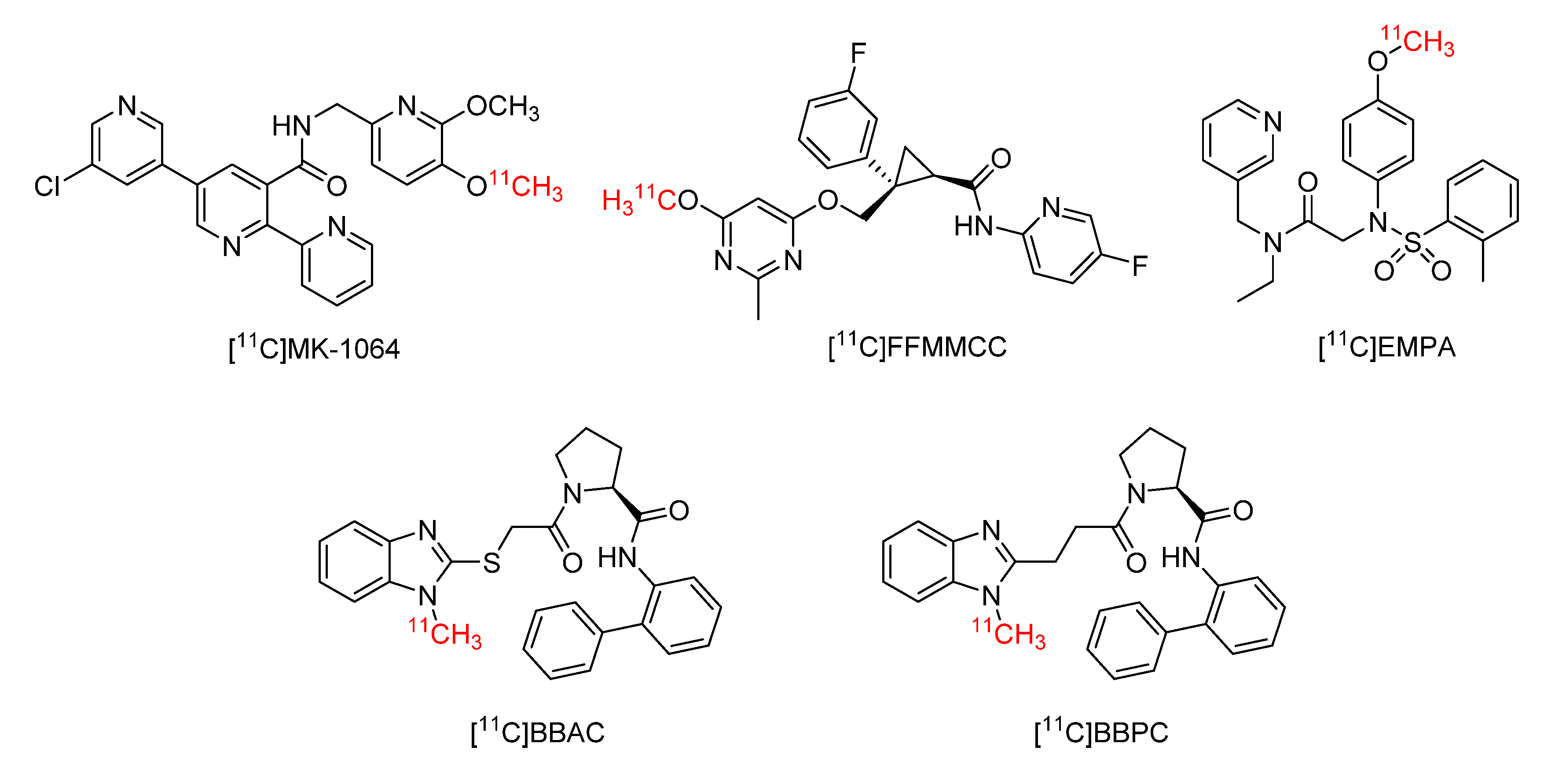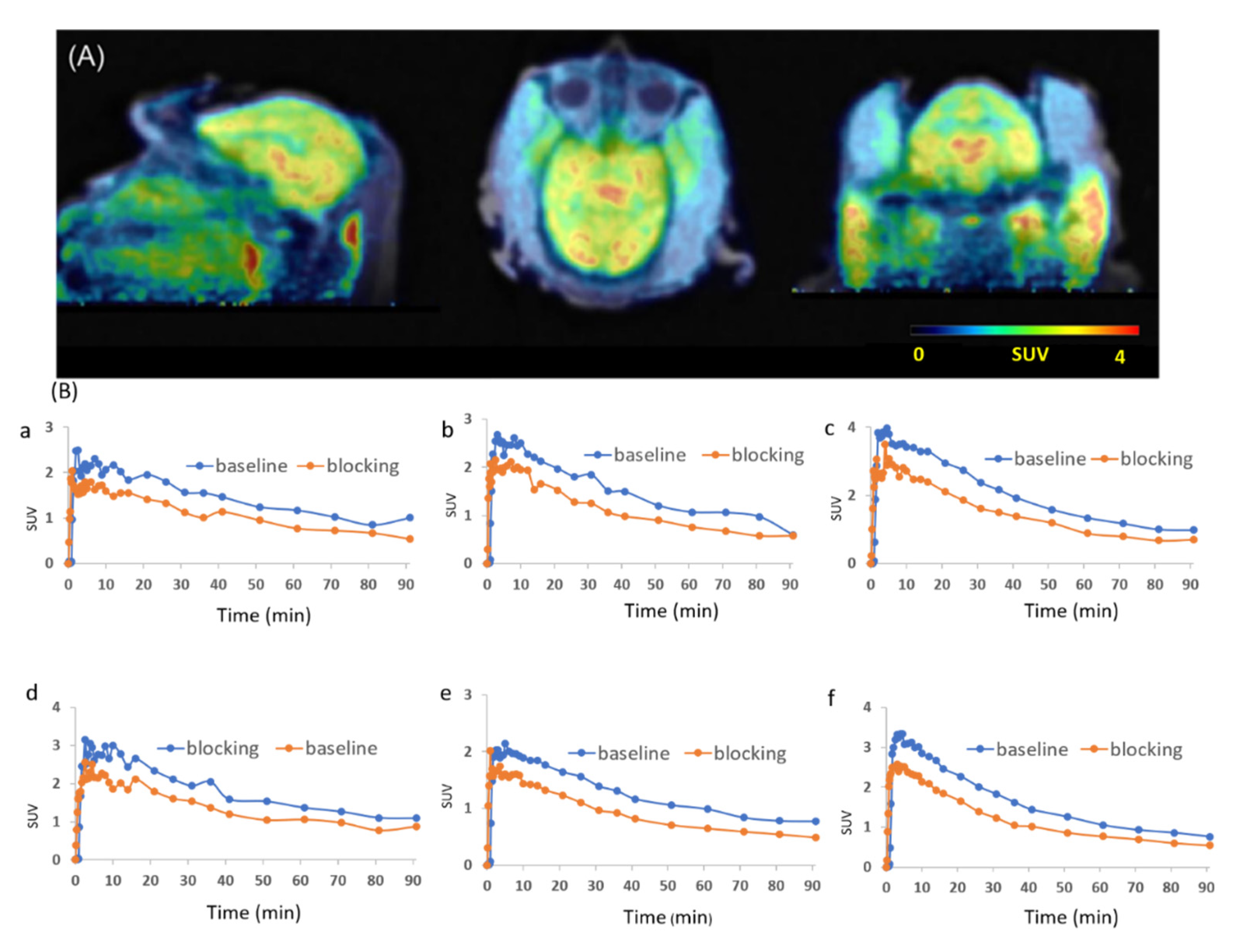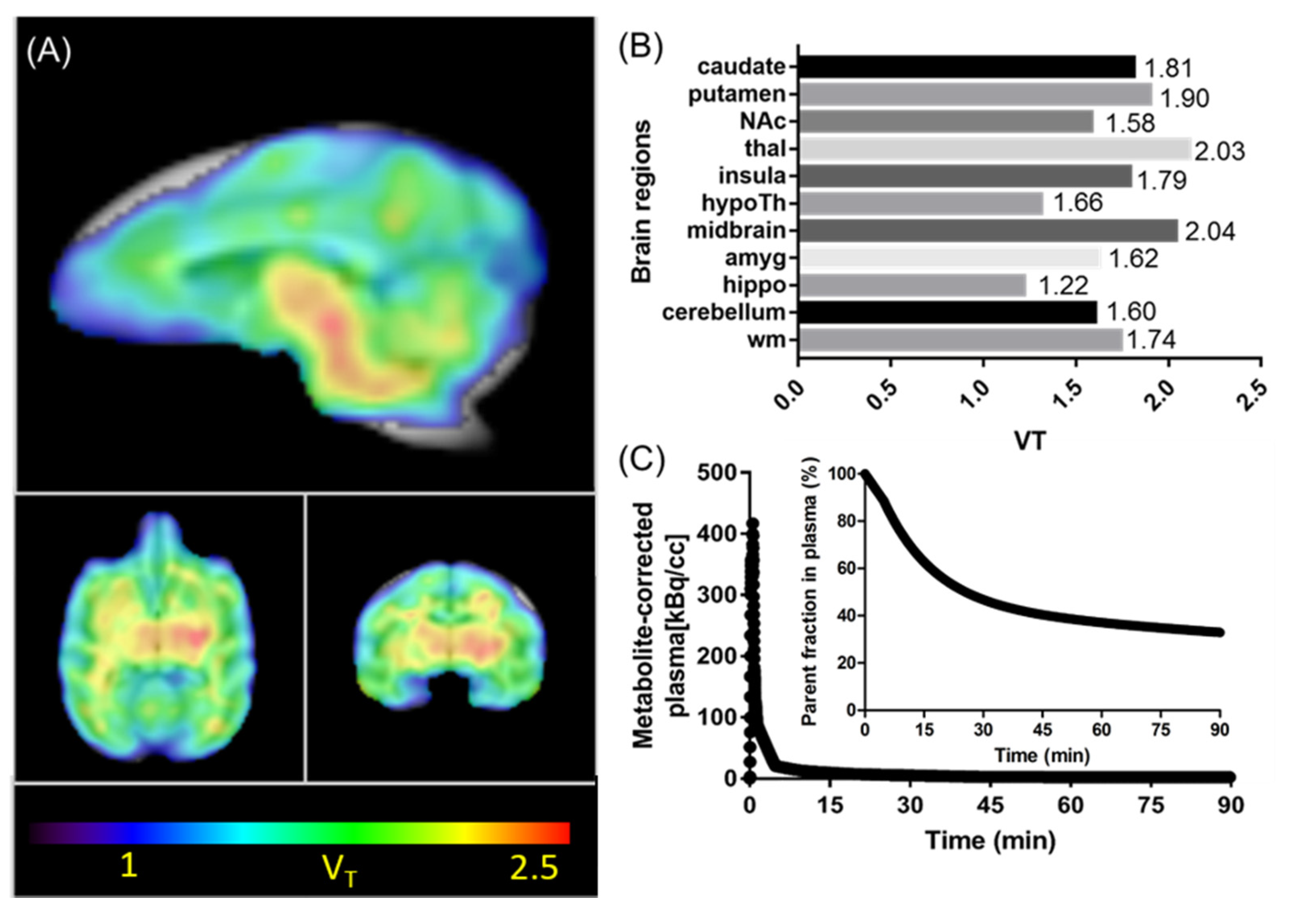A New Positron Emission Tomography Probe for Orexin Receptors Neuroimaging
Abstract
1. Introduction
2. Results and Discussion
2.1. Selection of Scaffold for Orexin Imaging Probe Development
2.2. Physicochemical Properties of CW24
2.3. Chemical Synthesis for CW24 and [11C]CW24
2.4. Mouse Imaging with [11C]CW24
2.5. Non-human Primate (NHP) Imaging with [11C]CW24
3. Materials and Methods
3.1. Synthesis of Compound CW24
3.2. Radiosynthesis of [11C]CW24
3.3. Assessment of Lipophilicity (Log D; pH 7.4)
3.4. Human Orexin GPCR Binding (Agonist Radioligand) Assay
3.5. Rodent PET/CT Acquisition
3.6. Rodent PET/CT Image Analysis
3.7. Macaque PET-MR Acquisition
3.8. PET-MR Imaging Data Analysis for the Macaque Study
3.9. Plasma and Metabolite Analysis
4. Conclusions
Supplementary Materials
Author Contributions
Funding
Acknowledgments
Conflicts of Interest
References
- Ammoun, S.; Holmqvist, T.; Shariatmadari, R.; Oonk, H.B.; Detheux, M.; Parmentier, M.; Akerman, K.E.; Kukkonen, J.P. Distinct recognition of OX1 and OX2 receptors by orexin peptides. J. Pharmacol. Exp. Ther. 2003, 305, 507–514. [Google Scholar] [CrossRef] [PubMed]
- Bettica, P.; Squassante, L.; Groeger, J.A.; Gennery, B.; Winsky-Sommerer, R.; Dijk, D.J. Differential effects of a dual orexin receptor antagonist (SB-649868) and zolpidem on sleep initiation and consolidation, SWS, REM sleep, and EEG power spectra in a model of situational insomnia. Neuropsychopharmacology 2012, 37, 1224–1233. [Google Scholar] [CrossRef]
- Bingham, M.J.; Cai, J.; Deehan, M.R. Eating, sleeping and rewarding: Orexin receptors and their antagonists. Curr. Opin Drug Discov. Devel. 2006, 9, 551–559. [Google Scholar]
- Boutrel, B.; Kenny, P.J.; Specio, S.E.; Martin-Fardon, R.; Markou, A.; Koob, G.F.; de Lecea, L. Role for hypocretin in mediating stress-induced reinstatement of cocaine-seeking behavior. Proc. Natl. Acad. Sci. USA 2005, 102, 19168–19173. [Google Scholar] [CrossRef]
- Brisbare-Roch, C.; Dingemanse, J.; Koberstein, R.; Hoever, P.; Aissaoui, H.; Flores, S.; Mueller, C.; Nayler, O.; van Gerven, J.; de Haas, S.L.; et al. Promotion of sleep by targeting the orexin system in rats, dogs and humans. Nat. Med. 2007, 13, 150–155. [Google Scholar] [CrossRef]
- Cada, D.J.; Levien, T.L.; Baker, D.E. Suvorexant. Hosp Pharm. 2015, 50, 59–71. [Google Scholar] [CrossRef]
- Roecker, A.J.; Cox, C.D.; Coleman, P.J. Orexin receptor antagonists: New therapeutic agents for the treatment of insomnia. J. Med. Chem. 2016, 59, 504–530. [Google Scholar] [CrossRef]
- Bingham, S.; Davey, P.T.; Babbs, A.J.; Irving, E.A.; Sammons, M.J.; Wyles, M.; Jeffrey, P.; Cutler, L.; Riba, I.; Johns, A.; et al. Orexin-A, an hypothalamic peptide with analgesic properties. Pain 2001, 92, 81–90. [Google Scholar] [CrossRef]
- Tabaeizadeh, M.; Motiei-Langroudi, R.; Mirbaha, H.; Esmaeili, B.; Tahsili-Fahadan, P.; Javadi-Paydar, M.; Ghaffarpour, M.; Dehpour, A.R. The differential effects of OX1R and OX2R selective antagonists on morphine conditioned place preference in naive versus morphine-dependent mice. Behav. Brain Res. 2013, 237, 41–48. [Google Scholar] [CrossRef] [PubMed]
- De Lecea, L.; Kilduff, T.S.; Peyron, C.; Gao, X.; Foye, P.E.; Danielson, P.E.; Fukuhara, C.; Battenberg, E.L.; Gautvik, V.T.; Frankel, W.N.; et al. The hypocretins: Hypothalamus-specific peptides with neuroexcitatory activity. Proc. Natl. Acad Sci. USA 1998, 95, 322–327. [Google Scholar] [CrossRef] [PubMed]
- Sakurai, T.; Amemiya, A.; Ishii, M.; Matsuzaki, I.; Chemelli, R.M.; Tanaka, H.; Williams, S.C.; Richardson, J.A.; Kozlowski, G.P.; Wilson, S.; et al. Orexins and orexin receptors: A family of hypothalamic neuropeptides and G protein-coupled receptors that regulate feeding behavior. Cell 1998, 92, 573–585. [Google Scholar] [CrossRef]
- Marcus, J.N.; Aschkenasi, C.J.; Lee, C.E.; Chemelli, R.M.; Saper, C.B.; Yanagisawa, M.; Elmquist, J.K. Differential expression of orexin receptors 1 and 2 in the rat brain. J. Comp. Neurol. 2001, 435, 6–25. [Google Scholar] [CrossRef] [PubMed]
- Suzuki, H.; Takemoto, Y.; Yamamoto, T. Differential distribution of orexin-A-like and orexin receptor 1 (OX1R)-like immunoreactivities in the Xenopus pituitary. Tissue Cell 2007, 39, 423–430. [Google Scholar] [CrossRef] [PubMed]
- Mahler, S.V.; Smith, R.J.; Moorman, D.E.; Sartor, G.C.; Aston-Jones, G. Multiple roles for orexin/hypocretin in addiction. Prog. Brain Res. 2012, 198, 79–121. [Google Scholar] [PubMed]
- Ida, T.; Nakahara, K.; Murakami, T.; Hanada, R.; Nakazato, M.; Murakami, N. Possible involvement of orexin in the stress reaction in rats. Biochem. Biophys. Res. Commun. 2000, 270, 318–323. [Google Scholar] [CrossRef]
- Furlong, T.M.; Vianna, D.M.; Liu, L.; Carrive, P. Hypocretin/orexin contributes to the expression of some but not all forms of stress and arousal. Eur. J. Neurosci. 2009, 30, 1603–1614. [Google Scholar] [CrossRef]
- Stachulski, A.V.; Baillie, T.A.; Park, B.K.; Obach, R.S.; Dalvie, D.K.; Williams, D.P.; Srivastava, A.; Regan, S.L.; Antoine, D.J.; Goldring, C.E.; et al. The generation, detection, and effects of reactive drug metabolites. Med. Res. Rev. 2013, 33, 985–1080. [Google Scholar] [CrossRef]
- Bettica, P.; Squassante, L.; Zamuner, S.; Nucci, G.; Danker-Hopfe, H.; Ratti, E. The orexin antagonist SB-649868 promotes and maintains sleep in men with primary insomnia. Sleep 2012, 35, 1097–1104. [Google Scholar] [CrossRef]
- Hirose, M.; Egashira, S.; Goto, Y.; Hashihayata, T.; Ohtake, N.; Iwaasa, H.; Hata, M.; Fukami, T.; Kanatani, A.; Yamada, K. N-acyl 6,7-dimethoxy-1,2,3,4-tetrahydroisoquinoline: The first orexin-2 receptor selective non-peptidic antagonist. Bioorg. Med. Chem. Lett. 2003, 13, 4497–4499. [Google Scholar] [CrossRef]
- Whitman, D.B.; Cox, C.D.; Breslin, M.J.; Brashear, K.M.; Schreier, J.D.; Bogusky, M.J.; Bednar, R.A.; Lemaire, W.; Bruno, J.G.; Hartman, G.D.; et al. Discovery of a potent, CNS-penetrant orexin receptor antagonist based on an n,n-disubstituted-1,4-diazepane scaffold that promotes sleep in rats. Chem. Med. Chem. 2009, 4, 1069–1074. [Google Scholar] [CrossRef]
- Malherbe, P.; Borroni, E.; Pinard, E.; Wettstein, J.G.; Knoflach, F. Biochemical and electrophysiological characterization of almorexant, a dual orexin 1 receptor (OX1)/orexin 2 receptor (OX2) antagonist: Comparison with selective OX1 and OX2 antagonists. Mol. Pharmacol. 2009, 76, 618–631. [Google Scholar] [CrossRef] [PubMed]
- McAtee, L.C.; Sutton, S.W.; Rudolph, D.A.; Li, X.; Aluisio, L.E.; Phuong, V.K.; Dvorak, C.A.; Lovenberg, T.W.; Carruthers, N.I.; Jones, T.K. Novel substituted 4-phenyl-[1,3]dioxanes: Potent and selective orexin receptor 2 (OX(2)R) antagonists. Bioorg. Med. Chem. Lett. 2004, 14, 4225–4229. [Google Scholar] [CrossRef] [PubMed]
- Porter, R.A.; Chan, W.N.; Coulton, S.; Johns, A.; Hadley, M.S.; Widdowson, K.; Jerman, J.C.; Brough, S.J.; Coldwell, M.; Smart, D.; et al. 1,3-Biarylureas as selective non-peptide antagonists of the orexin-1 receptor. Bioorg. Med. Chem. Lett. 2001, 11, 1907–1910. [Google Scholar] [CrossRef]
- Smart, D.; Sabido-David, C.; Brough, S.J.; Jewitt, F.; Johns, A.; Porter, R.A.; Jerman, J.C. SB-334867-A: The first selective orexin-1 receptor antagonist. Br. J. Pharmacol. 2001, 132, 1179–1182. [Google Scholar] [CrossRef] [PubMed]
- Srinivasan, S.; Simms, J.A.; Nielsen, C.K.; Lieske, S.P.; Bito-Onon, J.J.; Yi, H.; Hopf, F.W.; Bonci, A.; Bartlett, S.E. The dual orexin/hypocretin receptor antagonist, almorexant, in the ventral tegmental area attenuates ethanol self-administration. PLoS ONE 2012, 7, e44726. [Google Scholar] [CrossRef]
- Gao, M.; Wang, M.; Zheng, Q.H. Synthesis of [(11)C]MK-1064 as a new PET radioligand for imaging of orexin-2 receptor. Bioorg. Med. Chem. Lett. 2016, 26, 3694–3699. [Google Scholar] [CrossRef]
- Wang, C.; Moseley, C.K.; Carlin, S.M.; Wilson, C.M.; Neelamegam, R.; Hooker, J.M. Radiosynthesis and evaluation of [11C]EMPA as a potential PET tracer for orexin 2 receptors. Bioorg. Med. Chem. Lett. 2013, 23, 3389–3392. [Google Scholar] [CrossRef]
- Liu, F.; Majo, V.J.; Prabhakaran, J.; Castrillion, J.; Mann, J.J.; Martinez, D.; Kumar, J.S. Radiosynthesis of [11C]BBAC and [11C]BBPC as potential PET tracers for orexin2 receptors. Bioorg. Med. Chem. Lett. 2012, 22, 2172–2174. [Google Scholar] [CrossRef]
- Wang, C.; Wilson, C.M.; Moseley, C.K.; Carlin, S.M.; Hsu, S.; Arabasz, G.; Schroeder, F.A.; Sander, C.Y.; Hooker, J.M. Evaluation of potential PET imaging probes for the orexin 2 receptors. Nucl. Med. Biol. 2013, 40, 1000–1005. [Google Scholar] [CrossRef]
- Cox, C.D.; McGaughey, G.B.; Bogusky, M.J.; Whitman, D.B.; Ball, R.G.; Winrow, C.J.; Renger, J.J.; Coleman, P.J. Conformational analysis of N,N-disubstituted-1,4-diazepane orexin receptor antagonists and implications for receptor binding. Bioorg. Med. Chem. Lett. 2009, 19, 2997–3001. [Google Scholar] [CrossRef]
- Steiner, M.A.; Gatfield, J.; Brisbare-Roch, C.; Dietrich, H.; Treiber, A.; Jenck, F.; Boss, C. Discovery and characterization of ACT-335827, an orally available, brain penetrant orexin receptor type 1 selective antagonist. Chem. Med. Chem. 2013, 8, 898–903. [Google Scholar] [CrossRef] [PubMed]
- Betschart, C.; Hintermann, S.; Behnke, D.; Cotesta, S.; Fendt, M.; Gee, C.E.; Jacobson, L.H.; Laue, G.; Ofner, S.; Chaudhari, V.; et al. Identification of a novel series of orexin receptor antagonists with a distinct effect on sleep architecture for the treatment of insomnia. J. Med. Chem. 2013, 56, 7590–7607. [Google Scholar] [CrossRef]
- Callander, G.E.; Olorunda, M.; Monna, D.; Schuepbach, E.; Langenegger, D.; Betschart, C.; Hintermann, S.; Behnke, D.; Cotesta, S.; Fendt, M.; et al. Kinetic properties of "dual" orexin receptor antagonists at OX1R and OX2R orexin receptors. Front. Neurosci. 2013, 7, 230. [Google Scholar] [CrossRef] [PubMed]
- Zhang, L.; Villalobos, A.; Beck, E.M.; Bocan, T.; Chappie, T.A.; Chen, L.; Grimwood, S.; Heck, S.D.; Helal, C.J.; Hou, X.; et al. Design and selection parameters to accelerate the discovery of novel central nervous system positron emission tomography (PET) ligands and their application in the development of a novel phosphodiesterase 2A PET ligand. J. Med. Chem. 2013, 56, 4568–4579. [Google Scholar] [CrossRef] [PubMed]
- Seo, Y.J.; Kang, Y.; Muench, L.; Reid, A.; Caesar, S.; Jean, L.; Wagner, F.; Holson, E.; Haggarty, S.J.; Weiss, P.; et al. Image-guided synthesis reveals potent blood-brain barrier permeable histone deacetylase inhibitors. ACS Chem. Neurosci. 2014, 5, 588–596. [Google Scholar] [CrossRef] [PubMed]
- Besnard, J.; Ruda, G.F.; Setola, V.; Abecassis, K.; Rodriguiz, R.M.; Huang, X.P.; Norval, S.; Sassano, M.F.; Shin, A.I.; Webster, L.A.; et al. Automated design of ligands to polypharmacological profiles. Nature 2012, 492, 215–220. [Google Scholar] [CrossRef]
- Van de Bittner, G.C.; Ricq, E.L.; Hooker, J.M. A philosophy for CNS radiotracer design. Acc. Chem. Res. 2014, 47, 3127–3134. [Google Scholar] [CrossRef]
- Wang, C.; Placzek, M.S.; Van de Bittner, G.C.; Schroeder, F.A.; Hooker, J.M. A Novel Radiotracer for Imaging Monoacylglycerol Lipase in the Brain Using Positron Emission Tomography. ACS Chem. Neurosci. 2016, 7, 484–489. [Google Scholar] [CrossRef]
- Wang, C.; Schroeder, F.A.; Hooker, J.M. Development of new positron emission tomography radiotracer for BET imaging. ACS Chem. Neurosci. 2017, 8, 17–21. [Google Scholar] [CrossRef]
- Rohlfing, T.; Kroenke, C.D.; Sullivan, E.V.; Dubach, M.F.; Bowden, D.M.; Grant, K.A.; Pfefferbaum, A. The INIA19 template and neuromaps atlas for primate brain image parcellation and spatial normalization. Front. Neuroinform 2012, 6, 27. [Google Scholar] [CrossRef]
- Bai, P.; Wey, H.-Y.; Patnaik, D.; Lu, X.; Rokka, J.; Stephanie, F.; Haggarty, S.J.; Wang, C. Positron emission tomography probes targeting bromodomain and extra-terminal (BET) domains to enable in vivo neuroepigenetic imaging. Chem. Commun. 2019, 55, 12932–12935. [Google Scholar] [CrossRef] [PubMed]
Sample Availability: Samples of the compounds (IPSU and CW24) are available from the authors. |






© 2020 by the authors. Licensee MDPI, Basel, Switzerland. This article is an open access article distributed under the terms and conditions of the Creative Commons Attribution (CC BY) license (http://creativecommons.org/licenses/by/4.0/).
Share and Cite
Bai, P.; Bai, S.; Placzek, M.S.; Lu, X.; Fiedler, S.A.; Ntaganda, B.; Wey, H.-Y.; Wang, C. A New Positron Emission Tomography Probe for Orexin Receptors Neuroimaging. Molecules 2020, 25, 1018. https://doi.org/10.3390/molecules25051018
Bai P, Bai S, Placzek MS, Lu X, Fiedler SA, Ntaganda B, Wey H-Y, Wang C. A New Positron Emission Tomography Probe for Orexin Receptors Neuroimaging. Molecules. 2020; 25(5):1018. https://doi.org/10.3390/molecules25051018
Chicago/Turabian StyleBai, Ping, Sha Bai, Michael S. Placzek, Xiaoxia Lu, Stephanie A. Fiedler, Brenda Ntaganda, Hsiao-Ying Wey, and Changning Wang. 2020. "A New Positron Emission Tomography Probe for Orexin Receptors Neuroimaging" Molecules 25, no. 5: 1018. https://doi.org/10.3390/molecules25051018
APA StyleBai, P., Bai, S., Placzek, M. S., Lu, X., Fiedler, S. A., Ntaganda, B., Wey, H.-Y., & Wang, C. (2020). A New Positron Emission Tomography Probe for Orexin Receptors Neuroimaging. Molecules, 25(5), 1018. https://doi.org/10.3390/molecules25051018




